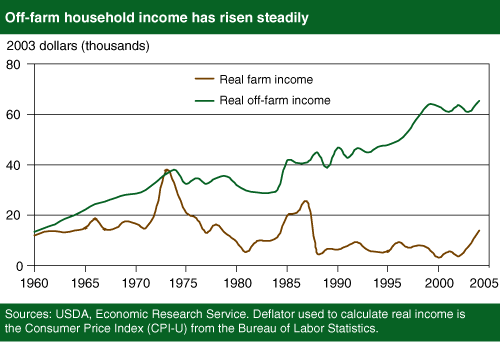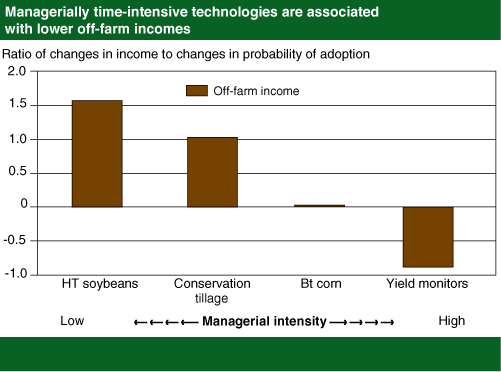Farmers Balance Off-Farm Work and Technology Adoption
- by Jorge Fernandez-Cornejo
- 2/1/2007
Highlights
- Off-farm income has risen steadily over recent decades. Small-farm households are more likely than larger farms to devote time to off-farm employment.
- New technologies enhance options for trading onfarm work for off-farm employment.
- Farm households with higher off-farm income are more likely to adopt farm technologies that economize on management time than those that are time intensive.
Effectively managing land, water, machinery, and other inputs—as well as adopting new technologies and production practices—can help ensure the success of a farm business and the economic well-being of a farm household. Yet, farm operators and their household members are increasingly relying on off-farm employment to improve their bottom lines. While contributing to the economic well-being of farm households, off-farm jobs compete with onfarm responsibilities for managerial time, which, in turn, may affect the economic performance of the farm business. Consequently, time-saving benefits are driving the decisions of certain farm operator households to adopt new technologies and practices.
In addition to sustaining growth in agricultural productivity and ensuring an abundance of food and fiber, adopting innovative farm technologies also changes the way farm households regard employment choices. A recent ERS study finds that the adoption of time-saving technologies, such as herbicide-tolerant (HT) soybeans, is associated with higher off-farm incomes (see box, “Modeling Off-Farm Income and Technology Adoption”). On the other hand, the adoption of time-intensive technologies such as precision farming is more closely associated with lower off-farm incomes. These findings confirm a trade-off between the time spent on farm and off-farm activities, which, in turn, translates into a trade-off between expanding farm operations and increasing off-farm income-generating activities.
Off-Farm Income Is Increasingly Important for Farm Households
Off-farm income received by farm operators and their spouses has risen steadily over recent decades as job opportunities have grown and mechanization and other technological innovations have lessened onfarm labor needs. Off-farm income as a share of total U.S. farm household income rose from about 50 percent in 1960 to more than 80 percent over the past 10 years. On average, a farm household received about $81,500 in 2004, netting only $14,200 from farming activities. Earned off-farm income averaged $48,800 and unearned income was about $18,500 (Social Security, interest, etc.). Fifty-two percent of farm operators worked off-farm in 2004, up from 44 percent in 1979. Over the same period, the share of spouses working off-farm grew from 28 to 45 percent.
Not surprisingly, the amount of time allocated to off-farm employment has also risen. From 1996 to 2004, farm operators increased their average time employed off-farm 20 percent from 830 hours to 1,002 hours, while not markedly changing the number of hours spent working on the farm (1,525 hours in 1996 and 1,574 in 2004). Over the same period, the spouses of farm operators increased their average off-farm work hours from 690 to 809 per year.
Small Farms Are Particularly Dependent on Off-Farm Income
Operators of smaller farms have higher off-farm incomes, both earned and total, than operators of larger farms. In 2004, farm households with gross farm sales less than $10,000 averaged just over $74,000 in off-farm income. In contrast, households with farm sales between $250,000 and $499,999 averaged about $45,000 in off-farm income. While off-farm income constitutes the largest component of total farm household income on average, its share decreases with farm size. Off-farm income is no longer the largest component of household income for those farms with gross sales higher than $250,000 (less than 8 percent of U.S. farms).
| Farm sales | Share of farms (percent) | Total off-farm income ($) | Total farm income ($) |
|---|---|---|---|
| $9,999 or less | 43.7 | 74,033 | -2,878 |
| $10,000-$99,999 | 40.7 | 67,971 | 4,091 |
| $100,000-$249,999 | 7.9 | 46,913 | 33,999 |
| $250,000-$499,999 | 4.2 | 44,870 | 79,516 |
| $500,000-$999,999 | 2.0 | 52,077 | 116,766 |
| $1,000,000 or more | 1.5 | 41,082 | 370,184 |
| All farms | 100.00 | 67,279 | 14,201 |
| Source: 2004 Agricultural Resource Management Survey. | |||
The inverse relationship between off-farm earned income and farm size is largely attributed to a higher likelihood of off-farm employment and more hours worked off the farm by operators of smaller farms. More than 55 percent of operators with farm sales less than $100,000 reported off-farm hours in 2004, versus 20 percent or less for operators of farms with sales above $250,000. However, off-farm income obtained by those farm operators who work off-farm does not vary much with farm size, averaging $47,000 for operators of the smallest farms and $39,000 for those of the largest farms.
Off-Farm Work Has Implications for Technology Adoption
Farmers choose technologies and practices they expect to yield the greatest net benefits based on their own preferences, farm characteristics, demand for their product, ease of application, and costs. Traditional economic research examines the benefits and costs of adopting agricultural innovations focusing on the farm business. However, an analysis based solely on net returns does not sufficiently explain variations in the rates of adoption for many recent agricultural innovations because the value of management time is excluded. For example, farmers rapidly adopted HT soybeans even though they showed no significant advantage in net returns over conventional soybeans. On the other hand, farmers have been slow to adopt other technologies, such as integrated pest management (IPM), despite the potential for higher net returns and other advantages. Such examples suggest that, in many cases, adoption of new farm technologies and practices is driven by “unquantified” factors, such as simplicity and flexibility of use, that translate into reduced managerial intensity and more free time for other activities, particularly off-farm employment.
USDA survey results show operators of high-sales, large, and very large farms—which depend on farm revenues more than on off-farm earnings—tend to adopt more management-intensive technologies. For example, 18 percent of the operators of large farms adopted precision farming in 1998, compared with 3 percent of small-farm operators (who worked fewer on-farm hours).
Technology Adoption and Household Income
ERS examined the interaction of off-farm income-earning activities and adoption of four agricultural technologies of varying managerial intensity—herbicide-tolerant crops, conservation tillage, insect-resistant (Bt) corn, and yield monitors (see box, “Selected Agricultural Technologies”). This research also considered the relationship between the adoption of these innovations and farm household income from onfarm and off-farm sources.
Adoption of HT soybeans, first introduced in 1996, grew 70 percent in just 5 years, despite no significant impacts on farm financial net returns. However, after controlling for other factors, a 16-percent increase in off-farm household income is associated with a 10-percent increase in the probability of adopting HT soybeans. This finding suggests that operators employed off-farm are more likely to adopt HT soybeans because the simplicity and flexibility of weed control saves managerial time. Also, a 9.7-percent increase in total household income is associated with a 10-percent increase in the likelihood of adoption of HT soybeans.
Similarly, a nearly 10-percent increase in off-farm household income (and a nearly 5-percent gain in total household income) is associated with a 10-percent increase in the probability of adopting conservation tillage. Conservation tillage is believed to be a management labor-saving practice, but to a lesser degree than use of HT soybeans.
On the other hand, the adoption of yield monitors, a key component of precision agriculture, is associated with lower off-farm income. An 8.4-percent decrease in off-farm household income is associated with a 10-percent increase in the probability of adopting yield monitors. These techniques are managerially time intensive, compared with HT soybeans and conservation tillage, which are managerially time saving.
The adoption of Bt corn did not show a significant relationship to off-farm household income, indicating that Bt corn may be managerially time neutral. Before the commercial introduction of Bt corn in 1996, most farmers accepted yield losses rather than incur the expense and uncertainty of chemical control. For those farmers, the use of Bt corn reportedly resulted in yield gains rather than pesticide savings, and savings in managerial time also were small.
Time/Income Trade-Offs Have Policy Implications
Findings confirm a trade-off between time spent on farm and off-farm activities. Households operating small farms are more likely than larger farm types to devote time to off-farm opportunities and to adopt management-saving technologies (such as herbicide-tolerant crops). Small-farm households are less likely to adopt management-intensive technologies, such as integrated pest management.
The relationship between off-farm work and a farm’s economic performance also suggests that a farm household’s dependence on off-farm income affects the distributional consequences of agricultural policies. Conservation, research and development, extension services, and farm support programs may affect farm households differently depending on the relative importance of onfarm and off-farm income-generating activities. Thus, the consequences of government policies are largely dependent on the diversity of U.S. farm households, particularly regarding their income sources. For example, a policy promoting the adoption of management-intensive agricultural practices (such as IPM) may be less effective unless it takes into consideration the demands on managerial time required by the particular practice.
These findings also have implications for private agricultural research and development (R&D). Innovators often base their economic evaluations of returns to R&D on the expected profitability of potential innovations for farmers. For example, innovators may consider the extent of yield increases and/or input cost reductions resulting from a new technology relative to the costs of adoption and current management practices. This research shows that the value of management time is an important additional element to be included in the economic evaluations of new technologies.
This article is drawn from:
- Fernandez-Cornejo, J. (2007). Off-Farm Income, Technology Adoption, and Farm Economic Performance. U.S. Department of Agriculture, Economic Research Service. ERR-36.
You may also like:
- Does Off-Farm Work Hinder ‘Smart’ Farming?. (2002). Economic Research Service. in Agricultural Outlook AO-294..



